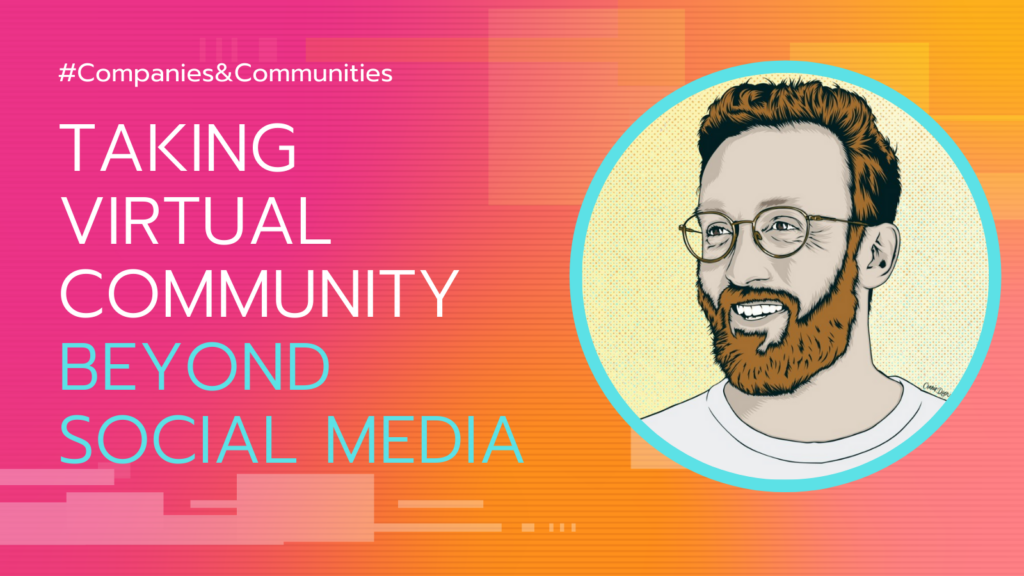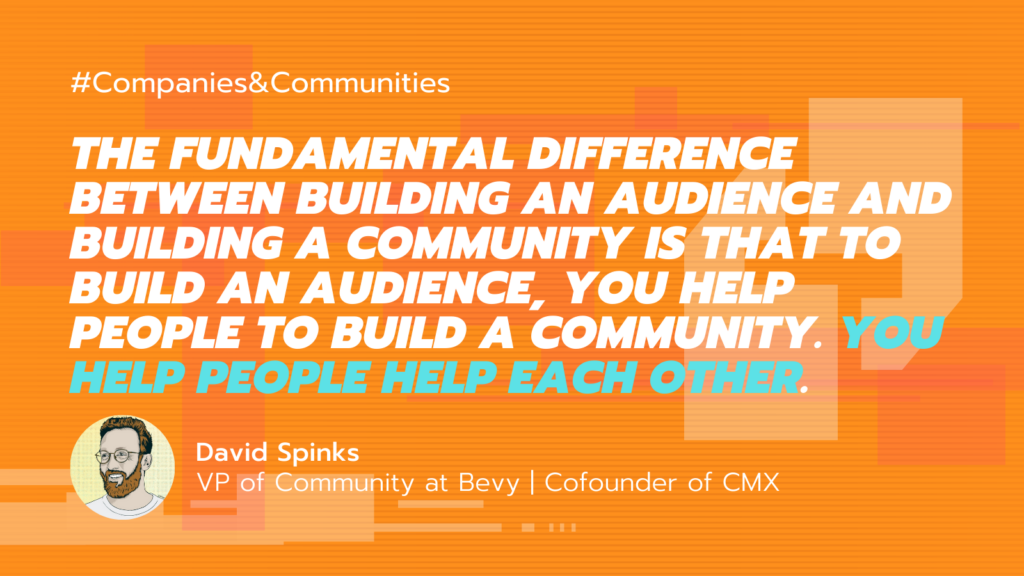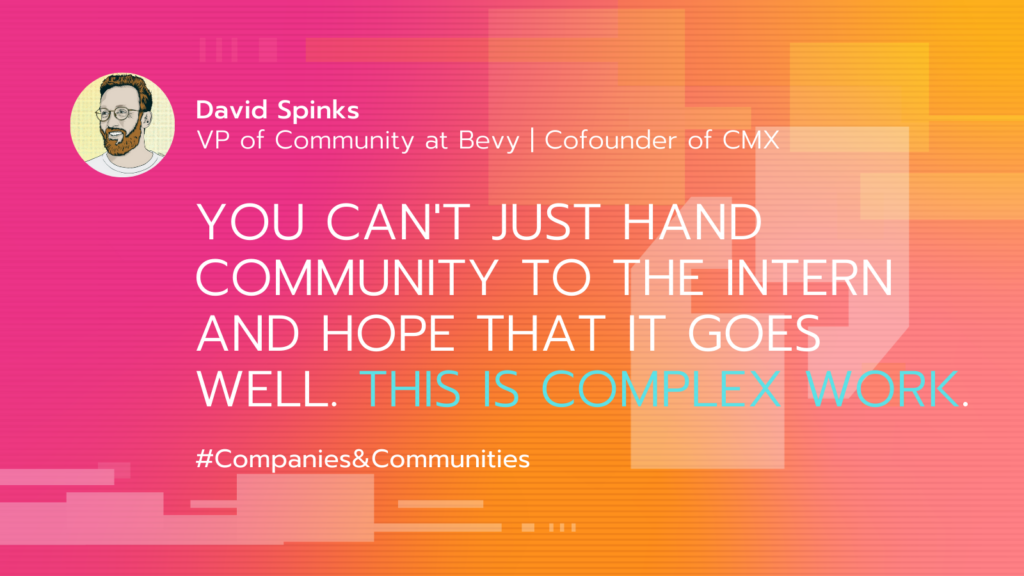
Community Building Strategy Beyond Social Media with CMX Co-Founder David Spinks

When many business people talk about community, they usually think of social media in some form or fashion as being central to the conversation. But there’s a lot of value in looking to expand community building strategy beyond social networks.
Bevy’s VP of Community David Spinks, who also co-founded a huge collective for community professionals, literally wrote the book on community building. (It’s called The Business of Belonging.) He holds years of experience with building communities, both online and offline.
According to David, “A business is just groups of people building things for groups of people. It’s all people. It’s all community.”
So what is the main difference between social media and business community?
Related Content: How Wattpad Community Marketing Led To 90M Users & A Netflix Hit
“I think social media is generally more of social media marketing. It’s building an audience, it’s connecting with people.”
“Can you connect with your community members there? Absolutely. But the fundamental difference between building an audience and building a community is that to build an audience you help people to build a community. You help people help each other.”
“It’s about creating this network of contribution and ownership and leadership where people can now create value for each other, rather than you having to create value for everyone else.”
Here are 5 additional things you should know about business community building strategy from my interview with David.
1. Community also doesn’t always tie back to marketing.
Most businesses do tend to categorize it within marketing.
But every part of the company can use community. The community team serves as kind of a center of excellence, defining the processes, values, how community operates within the organization.
But community can drive many different parts of the business as well.
2. Community building strategy should always include metrics to measure success.
The beautiful thing about community is that there are countless ways to build community.
You can host events, launch private groups. Or have 10-person intimate conversations.
You can do it online, you can do it offline.
But if you start and then try to figure out the business value, that’s where you end up doing all of these different kinds of community things without actually knowing whether it’s going to add up to that business objective.
So you need to start with that business objective.
So if it’s e-commerce and it’s like, “Okay, we really need to get more customers,” then align with that goal.
Related Content: Lessons on Virtual Community Building Strategy Learned During the Pandemic
For support, it’s going to be reduced support costs, increased customer satisfaction, things like that.
For acquisition, it might be leads, sales, accepted, leads and opportunities, closed deals, things like that.
So each one of those can have a different set of metrics that you’ll track to measure the business value of the community.

3. Prioritize member safety by modeling the right community culture from the start.
I think there’s a lot we can learn from gaming about building community into the product itself, right?
Gaming is also very experienced with creating moderator programs, and they generally have these rabid fan bases. People really form their identities around the games that they play.
So there’s a lot of really strong community dynamics that we can learn from gaming.
The one area where I hope we don’t learn from gaming and gaming learns from other areas is in building inclusive and equitable communities.
Part of the challenge for the video game industry is that they launch to millions of people at once. And so it’s very hard to create a culture when you’re growing, you know, putting that many people in a room together at the same time
For business this is why it’s important to start smaller because it allows you to shape the culture and create a foundation and an example.
So if you start with 10 people, one, it is going to be a lot easier to make sure that group is diverse.
Related Content: 20 Of The Best Content Creation Tools
It’s much easier for you to influence culture because you’re also choosing those people. So you can choose people who embody the values that you’re trying to set as an example.
You can curate people who are thoughtful and empathetic, and then you can work with them to design the guidelines and the rules that you want to be there for the community in the future.
So then, as you bring in the next 10 people, that’s the example they see when they walk in the room. They see who the people are, how they treat each other, what the rules are, what the voice and the tone and the vibe are, and you can build on top of it from there.
Start small, and just don’t wait to invest in D&I.
This is a mistake that I’ve made in the past, not knowing enough to be intentional about it from day one. Because the longer you go without investing in it, it becomes a much steeper hill to climb later, right?
If you have a community of a thousand people and 99% are white, it’s going to be a lot harder to make people of color feel like this is a place for them and a place where they can feel welcome.
So starting very early, bringing in experts, if you’re not an expert, to help you shape these things and identify gaps.
Build a diverse team as well because your team being diverse will help you see gaps that you wouldn’t.
4. Small businesses and startups can be successful with community building strategy, despite limited resources.

Community tends to get the bottom of the barrel when it comes to resources because it’s historically really hard to tie back to business value, which is why it’s so important to understand the business value when you start out.
Not just to get buy-in from executives, but also just for yourself to know that the work you’re doing is driving impact. And then you can make a more clear case to get more budget and resources.
But that all said, there are free tools for building community.
You can launch a Facebook group today and start building community.
You can start hosting events today for free and just very quickly start building up a community.
It’s just human relationships.
And in fact, every startup has to build community in its early days because you’re trying to get early adopters to come be a fan of your product and your brand, even though your product still sucks and you haven’t found market fit.
Community is a core part of getting a company off the ground.
5. What are some examples of the best companies building community today?
Figma has done a great job of adopting certain elements from the gaming industry. They’ve built social structures and dynamics into collaborative design.
I share a ton in [The Business of Belonging], but yeah, Culture AMP is a really cool company in the people operations space. And they built their Culture First conference and community programs and the People Geek community for people ops professionals.
I love all these examples where you take a profession that people didn’t perceive as sexy. And then you create a community that makes them feel sexy. Like everyone just wants to feel sexy, right?
Ironclad does it for legal operations, for legal ops.
And they just hired their first chief community officer, and they run all these incredible community events that they can measure. It’s driven over $5 million in ARR for their product and their platform.
Related Content: 13 Tactics to Optimize Your Content Marketing Distribution
Duolingo is one of the gold standards for me. You know, their community built the language learning courses on the platform.
Then they started empowering their community members to self-organize events, which was a program we powered with Bevy. And so people could practice their languages with each other.
And at their peak, they’re running 2,600 events per month.
You can only do that if you take a community-driven approach.
If they wanted to host all the events for their community, how many could they host? Like 10, 20, maybe 30, a hundred if they hire a ton of event managers and operators to host that many every month.
But because they empower the community to do it, there’s almost no limit to how many events they could run.
Read another post: How Spotify Uses Personalized Marketing as a Competitive Edge
Interested in getting more content like this? Sign up for my newsletter and get fresh insight delivered to you weekly.


